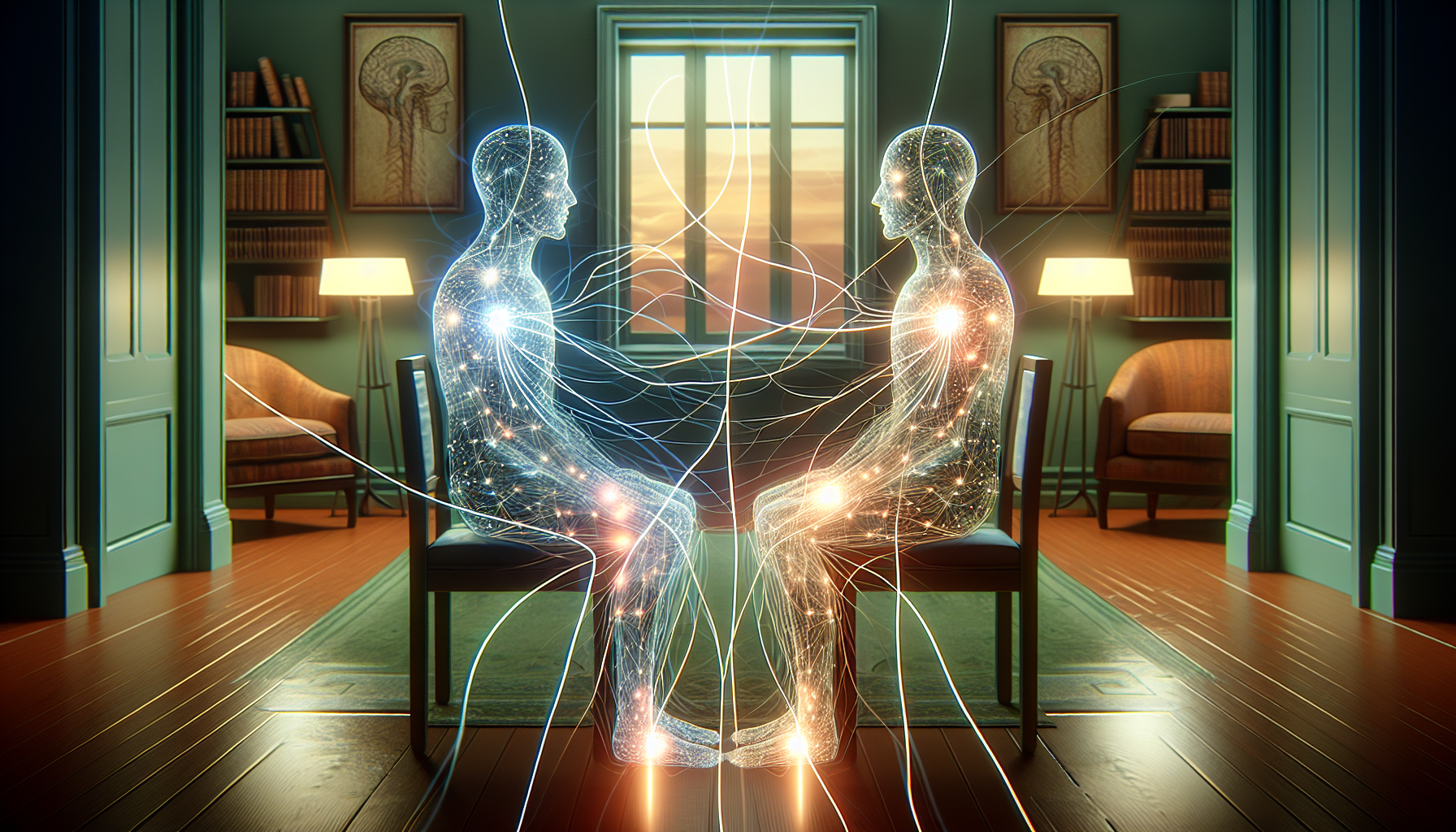Limbic resonance in couples therapy is a game-changer for deepening connections. This neural synchrony allows partners to truly feel and understand each other’s emotional states, serving as a powerful tool for enhancing intimacy. In this article, we’ll uncover how applying limbic resonance can invigorate your relationship, offering practical insights into its role in therapeutic practices.
Key Takeaways
- Limbic resonance is essential in forming deep emotional connections and is pivotal to lifelong emotional health, influencing our well-being through the empathic exchange and limbic regulation within relationships.
- Limbic resonance therapy involves various techniques like synchronized breathing, regular face-to-face interaction, and gratitude practices to help couples navigate emotional complexities and enhance their bond.
- The success of limbic resonance therapy relies on a combination of scientific understanding of limbic regulation and revision, and the use of targeted strategies for maintaining the calm and health of the limbic system post-therapy.
Unlocking Emotional Intimacy: The Power of Limbic Resonance in Relationships
Imagine a symphony where each note resonates with the other, creating harmony. The same is true for relationships, where the music of our emotions plays a pivotal role, much like a general theory that unifies various aspects.
Limbic resonance, a vibrant exchange of deep emotional states during caring interactions, serves as the bedrock of lifelong emotional health. This fundamental process lays the groundwork for forming emotional connections.
Engaging partners through multisensory stimulation like:
- sight
- sound
- touch
- scent
The phenomenon of limbic resonance occurs when individuals delve into the heart of limbic resonance. This interaction nurtures profound bonds, which have profound implications for our well-being.
The Essence of Limbic Resonance
Limbic resonance is the catalyst for emotional contagion, the empathic resonance that allows two people to sense and experience each other’s emotional states. When limbic resonance transpires, it resembles a duet of limbic systems, amplifying empathic feelings and bonding, thereby uplifting our happiness and well-being.
It’s the invisible thread that weaves through the fabric of intimate relationships, binding us on a deeper level than we can often comprehend.
The Limbic System’s Influence on Bonding
At the heart of this emotional interplay is the limbic system, a crucial component of our nervous systems, which serves as our brain’s emotional center. This complex network, including the amygdala, hippocampus, and thalamus, orchestrates our most intense emotions and memories, laying the foundation for emotional connections that define our close relationships. Our initial bonding experiences mold the limbic system’s wiring and impact our ability to form relationships and maintain emotional health in adulthood. The role of brain chemistry in this process cannot be overstated, as it directly influences the functioning of the limbic system.
The limbic brain, closely linked to the reptilian brain, also stores our emotional memories, both joyous and traumatic, which profoundly impacts how we share and shape feelings with others. The amygdala, in particular, governs our survival instincts, triggering reactions that can significantly influence the dynamics within our romantic partnerships.
Limbic Resonance Therapy in Action
Limbic resonance therapy is like a bridge reconnecting individuals to the warm currents of care and empathy that may have been obstructed by adverse experiences. In therapy sessions, an empathic resonance is fostered through a collaborative dialogue between therapist and client, creating a supportive environment where emotions are not only expressed but deeply understood.
The therapist’s brave engagement with another’s fragile neural rhythms enables limbic revision, fostering enduring changes that reach beyond the therapy room.
Cultivating a Harmonious Relationship: Techniques of Limbic Resonance Therapy
The journey towards a harmonious relationship is paved with the nuances of limbic resonance therapy, where therapists work with couples to navigate the complexities of their bond. From the initial de-escalation phase to the rejuvenation of intimacy, research-backed exercises are utilized to construct and revitalize romantic partnerships.
These exercises assist partners in recognizing their emotional states and the subsequent effects of their actions. This process is vital for pinpointing conflict roots and triggers of repeated disagreements.
Synchronized Breathing and Eye Contact
Amidst the rhythm of therapy, synchronized breathing emerges as a core practice. When partners breathe together, they engage in a mutual exchange that promotes emotional synchrony and a shared calm state. Eye contact also plays a significant role in this collaborative dance, nurturing intimacy and a deep sense of unity.
Through nonverbal communication, such as reciprocal body language exercises, couples can achieve a demonstrably attuned understanding, deepening their connection on a level beyond words.
Gratitude Practices and Regular Interaction
The digital age presents unique challenges to emotional health, with screen time often eclipsing the need for face-to-face social interactions. The result can be a draining of emotional charge, as the natural reciprocity of limbic resonance is sidelined. To counterbalance this, frequent interactions and gratitude practices are vital, preserving emotional connections and contributing to overall wellness.
These practices signal a departure from digital isolation, reactivating positive emotions within partners and fostering positive social interactions that resonate with the joy of being truly seen and understood.
The Science Behind Love: Understanding Limbic Regulation and Revision
Diving deeper into the science of love, we encounter limbic regulation and revision, processes that underpin the mutual dance of emotions between partners. The general theory of love explores how limbic regulation entails continuous adjustment of emotional states. This dynamic interplay can alter the brain’s structure and profoundly affect an individual’s personality over time.
Meanwhile, limbic revision offers a therapeutic path for fostering positive changes in personality, guided by the transformative power of deep emotional attunement and connection.
Limbic Regulation: Syncing Emotional States
Through techniques like gratitude practices, limbic regulation extends its influence to the nervous system, modulating heart rhythms and reducing negative emotional reactivity. This regulatory process not only supports bonding but also enhances mental health, as shown by the scientifically observed benefit of gratitude exercises on the brain’s emotional centers.
Guiding couples to synchronize their emotional states, limbic regulation eradicates negative interaction patterns, paving the way for a secure and resilient bond.
Limbic Revision: Rewiring for Positive Change
Limbic revision is akin to sculpting the emotional landscape of a relationship, reshaping the terrain through intentional therapeutic practices. Therapists skilled in limbic connections can revise neural patterns that dictate emotional life, opening doors to new emotional experiences and internal adaptation.
By reconfiguring the emotional parts of the brain, limbic revision aims to rewrite the narrative of the relationship, infusing it with trust, understanding, and an agreement that stands the test of time.
Healing Together: The Impact of Shared Emotional Experiences
Shared emotional experiences act as a conduit for intimacy and bonding, with emotional contagion playing a dual role in enhancing or hindering these connections. Couples sharing positive emotions through emotional contagion find their intimacy notably improved, whereas those absorbing each other’s negativity may find themselves in a conflict cycle.
To navigate these waters, couples can employ strategies like compartmentalizing emotions or dedicating time to process them together, protecting their emotional health and fortifying their bond.
Stages of Progress in Couples Therapy Featuring Limbic Resonance
Couples therapy featuring limbic resonance unfolds in stages, each one a step closer to emotional synchrony and a strengthened bond. The process commences with recognition and reflection, allowing couples to confront their emotional patterns and conflict triggers.
Progressing to emotional synchronization, therapists provide the tools and exercises needed to align couples’ emotional states and foster empathy. The final stage, strengthening the bond, consolidates the trust and understanding developed in the therapy, culminating in a relationship rejuvenated and resilient.
Phase One: Recognition and Reflection
The first phase, recognition and reflection, is a journey of self-discovery for couples. Partners begin by tuning in to their own emotions and how they ripple through their interactions. This reflective process unveils insights into the mutual impact they have on one another’s feelings, laying bare the triggers and underlying causes of their conflicts.
With a newfound understanding of these emotional patterns, couples set a foundation for conflict resolution and emotional growth.
Phase Two: Emotional Synchronization
In the emotional synchronization phase, the focus shifts to aligning the couple’s feelings, akin to two hearts beating as one. Therapists create a haven where partners can openly share and receive emotions, nurturing an environment where empathy flourishes.
It’s in this stage that the roots of a deeper emotional bond are sown, as couples learn the importance of being emotionally present for each other to fortify their connection.
Phase Three: Strengthening the Bond
The journey culminates in the strengthening of the bond phase, where couples work to transcend past negativity and differences, focusing on repairing and reinforcing their connection. Effective communication becomes the cornerstone here, allowing partners to articulate and empathize with each other’s core emotions.
Creating positive shared experiences replaces old negative memories, laying the groundwork for a revitalized and sturdy emotional foundation. The result is a relationship built on a bedrock of trust and understanding, a testament to the transformative power of limbic resonance therapy.
Navigating the Path to Calm: Limbic System Retraining Post-Therapy
The conclusion of therapy marks the start of maintaining a calm emotional state, essential for the ongoing health of the relationship. Sleep, for instance, plays a crucial role in modulating daily emotions and the ability to cope with emotional stress, directly impacting the couple’s emotional well-being.
By following a self-care routine with specific exercises, couples can preserve the serene state of their limbic systems, ensuring the longevity of their emotional connection.
Mindfulness and Meditation
Mindfulness and meditation serve as anchors in the quest for a tranquil limbic system. These practices reach into the depths of the brain, calming the limbic brain and fostering a sustainable emotional climate within relationships.
By dedicating a few minutes each day to meditation or mindful activity, individuals can manage challenging emotions more effectively, which in turn, contributes to the emotional health of the partnership.
Physical Touch and Togetherness
The natural design of our physical bodies and our innate need for social connections emphasize the importance of physical touch and togetherness post-therapy, as well as the physical responses that come with them. These simple yet profound acts include:
- Hugging
- Holding hands
- Cuddling
- Kissing
These acts trigger biological responses that are foundational to our roles as social animals and lovers.
By nurturing these biological needs, couples can solidify the emotional connections cultivated during therapy, ensuring a romantic partnership that continues to thrive in the presence of physical closeness and quality time shared together.
Limbic-Based Couples Therapy at the Bay Area CBT Center
Selecting the appropriate therapist is vital for navigating the realm of limbic-based couples therapy. At the Bay Area CBT Center, somatic therapy merges body-mind techniques with an inner knowing, paving the way for emotional healing through connection. The center’s therapists, adept in Somatic Experiencing and other nuanced methods, help individuals release trauma stored in the body, thus facilitating a deeper empathy and understanding in the relationship.
With a commitment to holistic healing, the center’s approach is comprehensive, integrating trauma healing into attachment-focused practices that aim for personal transformation and long-term solutions.
























































